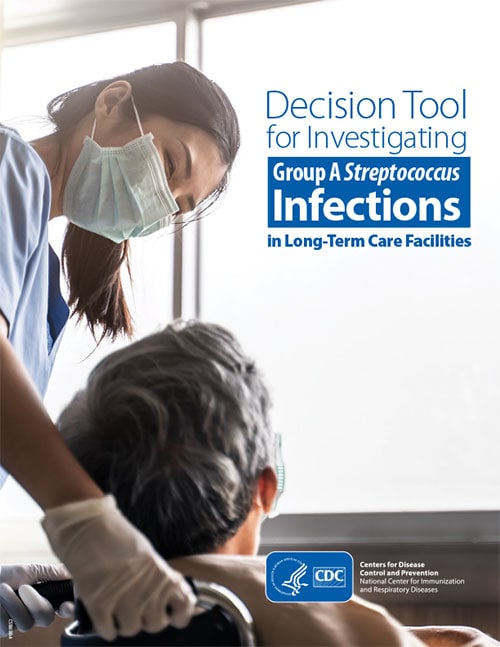Group A Strep in Long-term Care Facilities: Identifying and Managing Outbreaks
- Group A Streptococcus (GAS) infections are a serious cause of illness and death for adults 65 years of age or older in the United States.
- Residents of long-term care facilities (LTCFs) are particularly at risk for severe infection and death from GAS infections.
- Strong infection prevention and control practices are critical to stopping GAS transmission and preventing outbreaks in LTCFs.
- These investigation tools provide detailed approaches to investigating and controlling GAS outbreaks in LTCFs.
Toolkit for investigating and controlling outbreaks
This toolkit is intended for use by personnel in state, tribal, local, and territorial public health departments and LTCFs, including skilled nursing and rehabilitation facilities.
The investigation tools are a guide for addressing typical scenarios and do not encompass all LTCF GAS outbreak scenarios and response actions.
LTCF staff should work with their local public health departments when investigating suspected GAS outbreaks. Local public health departments can seek further assistance from their state, tribal, or territorial health departments. If needed, CDC is available for additional assistance.
Outbreaks of group A Streptococcus infections in long-term care facilities need to be investigated
Residents of long-term care facilities are at increased risk for disease and death from group A Streptococcus
Group A Streptococcus can be easily transmitted within and between long-term care facilities
Links to more information about prevention and control of group A Streptococcus infections in LTCFs
Definitions
Terms used in GAS outbreak investigations
Group A Streptococcus or GAS
Another name for Streptococcus pyogenes bacteria that cause many types of infections (these infections can be grouped into two general categories — invasive and non-invasive).
Invasive GAS infection
An illness with isolation (by culture) or identification (by molecular test) of GAS from either:
- A normally sterile site (e.g., blood, cerebrospinal fluid)
- A wound culture in a patient with necrotizing fasciitis or streptococcal toxic shock syndrome
Non-invasive GAS infection
Detection of GAS by isolation, molecular test, or rapid antigen detection test (also called a rapid strep test) from a non-sterile site (e.g., throat) in a patient who has a clinical presentation consistent with GAS infection, such as pharyngitis (also called strep throat) or wound infection, and who does not meet the invasive case definition.
Healthcare personnel (HCP)
Refers to all paid and unpaid people serving in healthcare settings who have the potential for direct or indirect exposure to patients or infectious materials, including body substances (e.g., blood, tissue, specific body fluids); contaminated medical supplies, devices, and equipment; contaminated environmental surfaces; or contaminated air (adapted from Terminology | HCP | Infection Control Guidelines Library | CDC).
GAS carriage
Presence of GAS in the throat or on the skin of a person who has no signs or symptoms of infection (also called colonization).
Outbreak
An increase in frequency of disease beyond that expected in a particular time and place.
